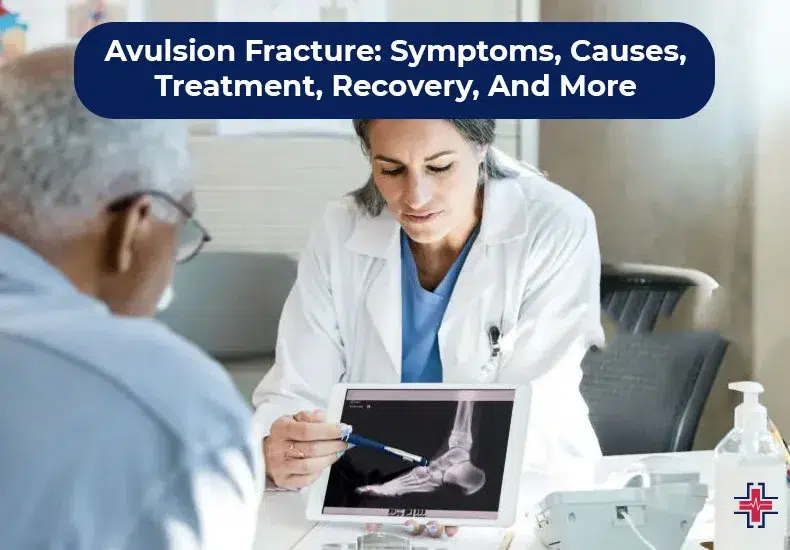An avulsion fracture occurs when a tendon or ligament attached to the bone pulls a piece of the fractured bone off. They can happen anywhere in the body but are most common in the finger, ankle, hip, and foot.
They are more common in children than adults but often affect adults who play sports. This article looks at the causes and symptoms of avulsion fractures. It also considers the treatment options and recovery for avulsion fractures to different parts of the body.
What is An Avulsion Fracture?
A fracture is a break or cracks in a bone that often results from an injury. With an avulsion fracture, an injury to the bone occurs near where the bone attaches to a tendon or ligament. When the fracture happens, the tendon or ligament pulls away, and a small piece of bone pulls away. Avulsion injury can occur in people who play sports.
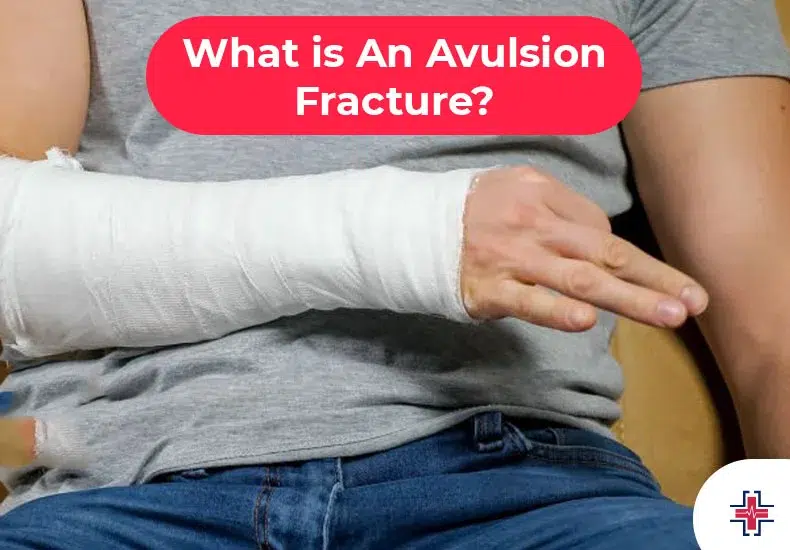
These fractures most often affect the elbow, hip, and ankle bones. Sometimes, you can get an avulsion fracture in other bones, such as the hand, finger, shoulder, or knee.
Symptoms of an avulsion fracture include
- Sudden, severe pain in the fracture
- Swelling
- Bruising
- Limited movement
- Pain when you try to move the bone
- Instability of a joint, or loss of function
Your doctor will examine the affected bone to see whether you can bend and straighten it. The doctor also may order X-rays to determine if you’ve fractured the bone.
Are Avulsion Fractures Serious?
Avulsion fractures, while generally considered less severe than some other types of fractures, can still pose significant health concerns depending on the location and extent of the injury. An Avulsion injury occurs when a tendon or ligament pulls away a tiny piece of bone, typically during a sudden and forceful movement. The seriousness of an avulsion fracture hinges on various factors, such as the affected bone, the size of the avulsed fragment, and the individual’s overall health.
In some instances, avulsion fractures may heal well with conservative treatments like rest, ice, and immobilization. However, more complex fractures or those involving weight-bearing joints may require surgical intervention to ensure proper alignment and stability. Prompt and accurate diagnosis is crucial to determine the appropriate course of action. While avulsion fractures are generally manageable, neglecting their severity or delaying treatment can lead to complications such as chronic pain, joint instability, or impaired function. It is essential for individuals who suspect an avulsion fracture to seek medical attention for a thorough evaluation and personalized treatment plan.
Types of Avulsion Fracture
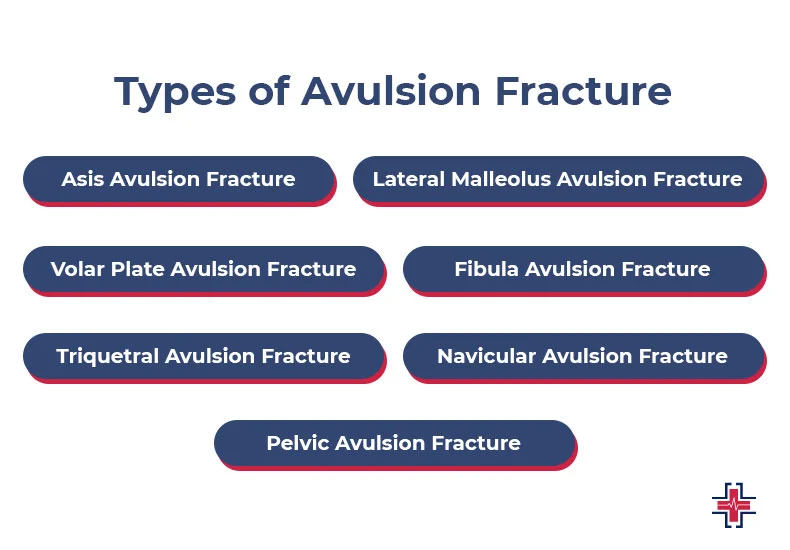
Asis Avulsion Fracture:
The Asis (anterior superior iliac spine) avulsion fracture occurs when the powerful hip flexor muscles, such as the rectus femoris, contract forcefully, leading to the pulling away of a small piece of the bony prominence at the front of the pelvic bone. This avulsion fracture often occurs in adolescents who participate in sports requiring sudden acceleration or deceleration.
Lateral Malleolus Avulsion Fracture:
A lateral malleolus avulsion fracture involves the fibula, specifically the bony prominence on the outer side of the ankle. This avulsion fracture often results from an abrupt twist or roll of the ankle, causing the ligaments attached to the lateral malleolus to pull off a fragment of bone. It is commonly associated with ankle sprains.
Volar Plate Avulsion Fracture:
Volar plate avulsion fractures typically occur at the base of the middle phalanx in the finger. The volar plate is a ligamentous structure that prevents hyperextension of the finger joints. Forceful hyperextension, often from a direct impact, can cause the volar plate to pull away a fragment of bone.
Fibula Avulsion Fracture:
Fibula avulsion fractures involve the fibula bone and typically occur at points where ligaments or tendons attach. These fractures are common in sports involving rapid changes in direction or sudden, powerful movements, leading to the forceful pulling away of a fibula fragment.
Triquetral Avulsion Fracture:
The triquetral avulsion fracture involves the triquetral bone in the wrist and is often associated with a fall onto an outstretched hand. The force of the fall can cause the ligaments attached to the triquetral bone to pull away a small fragment, resulting in this type of avulsion fracture.
Navicular Avulsion Fracture:
Navicular avulsion fractures occur at the navicular bone in the foot, commonly affecting athletes participating in repetitive foot-loading activities. These fractures often result from the excessive pull of the tibialis posterior tendon, leading to a fragment of the navicular bone being pulled away.
Pelvic Avulsion Fracture:
Pelvic avulsion fractures involve the detachment of a small bony fragment from the pelvic bone, typically at the site where powerful muscles and tendons attach. Commonly seen in adolescent athletes, these fractures can result from explosive movements or sudden contractions of the pelvic muscles. Proper diagnosis and management are crucial to ensure optimal recovery and prevent long-term complications.
What Are The Causes of Avulsion Fracture?
Avulsion fractures occur when a forceful pull or contraction of a muscle or tendon leads to the detachment of a small fragment of bone. Several causes contribute to the occurrence of avulsion fractures:
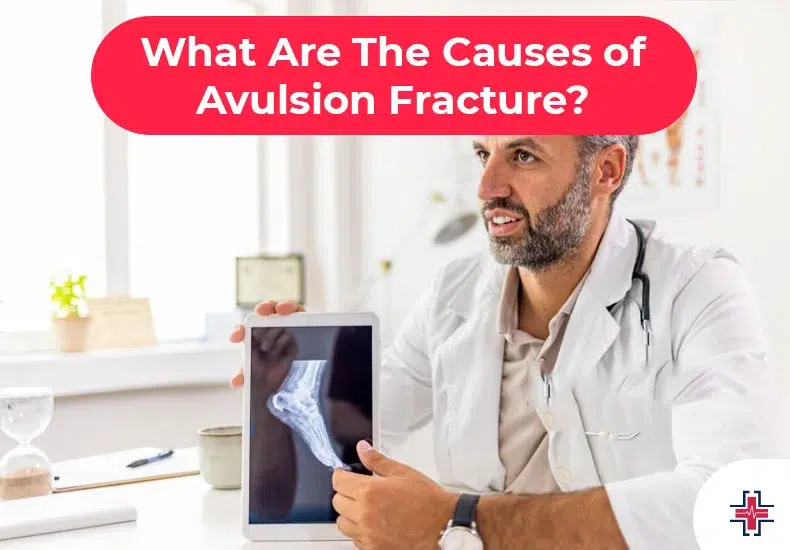
- Sudden Contraction of Muscles/Tendons:
Avulsion fractures often result from the abrupt and forceful contraction of muscles or tendons during sports or physical exercises. This can generate excessive tension on the attachment points, causing a fragment of bone to be pulled away.
- Traumatic Injuries:
Direct trauma to a specific area of the body can lead to avulsion fractures. Impact or collision during activities, sports falls, or accidents can cause the ligaments or tendons to exert a powerful force on the bone, resulting in the avulsion of a bony fragment.
- Overuse or Repetitive Stress:
Repetitive stress or overuse of particular body parts, especially in athletes or individuals engaged in repetitive activities, can contribute to avulsion fractures. Continuous stress on the bone from repetitive motions can weaken the attachment points, making them more susceptible to fracture.
- Sudden Twisting or Rotation:
Rapid and forceful twisting or rotational movements of a joint can lead to avulsion fractures. This is particularly common in joints like the ankle or knee, where sudden changes in direction or rotation can cause the ligaments or tendons to pull away a fragment of bone.
- Age and Growth Factors:
Adolescents, whose bones are still developing and growing, are more prone to Avulsion injury. The growth plates at the ends of bones are areas of vulnerability, and forceful muscle contractions during growth spurts can contribute to avulsion injuries.
- Poor Warm-up or Flexibility:
Inadequate warm-ups or flexibility exercises before engaging in physical activities can increase the risk of avulsion fractures. Proper warm-up helps prepare the muscles, tendons, and ligaments for the stresses of physical exertion, reducing the likelihood of injury.
What Are The Symptoms of Avulsion Fracture?
After sudden, severe pain, the most common symptoms of avulsion fractures include:
- Bruising.
- Swelling.
- Muscle pain.
- A popping or cracking sound.
- Pain that spreads to nearby parts of your body.
- Limping or an inability to walk if the broken bone is in or near your leg.
- Difficulty moving your limb.
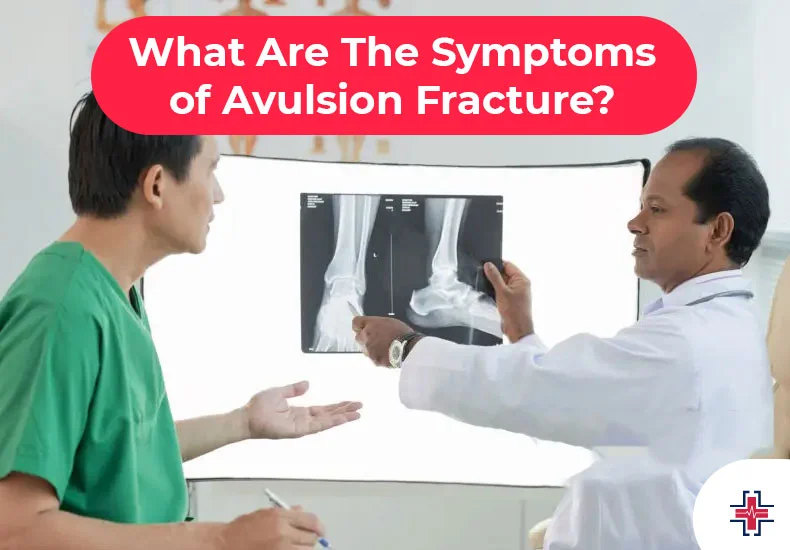
Speak with your healthcare provider about all your symptoms. It’s helpful for them to know every detail. You can help them determine your best treatment plan by providing as much information as possible.
How is An Avulsion Fracture Diagnosed?
Your healthcare providers at the emergency department will discuss your injury with you. They’ll ask you questions and perform tests to help diagnose your avulsion fracture. They’ll examine the affected area and see if you can move your bones. After that, there might be imaging tests to get a closer look. Tests might include.
- X-rays to look at your bones and joints.
- Computed tomography (CT scan) to look at your soft tissues and organs and get a more precise view of your bones and joints. Doctors carry out a computed tomography (CT scan) if X-rays are unclear.
What Are The Treatments of Avulsion Fractures?
The treatment approach for avulsion fractures depends on the specific location and severity of the injury. Here’s a general overview of the treatments for Avulsion injury in various areas of the body:
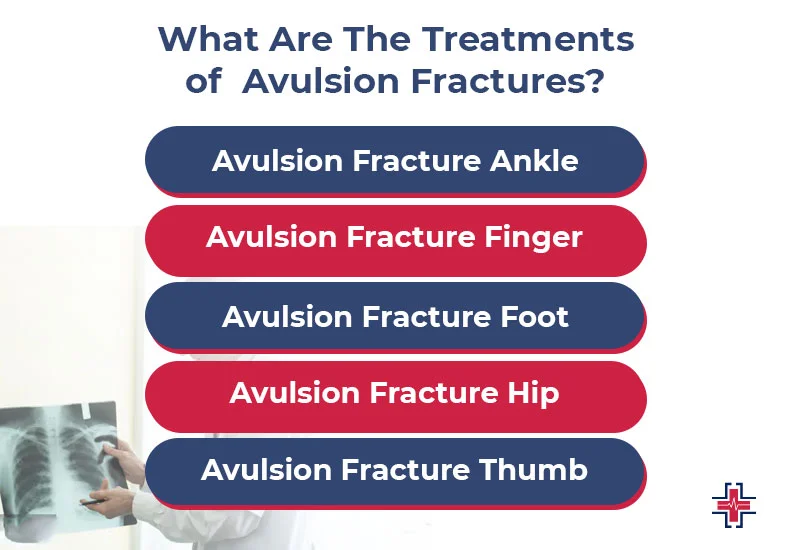
Individuals with avulsion fractures must consult with a healthcare professional for a proper diagnosis and tailored treatment plan. The fracture’s severity, displacement, and the patient’s overall health influence the treatment choice. Early intervention and adherence to the prescribed treatment plan are essential for optimal recovery and minimizing potential complications.
Avulsion Fracture Ankle
The main treatments for an ankle avulsion fracture are rest and icing. Keep weight off the ankle until it has healed, and take measures to reduce swelling by elevating the ankle and applying ice. Use an ice pack or ice wrapped in a towel when icing an injury. These steps will prevent further injury to the bone, and cooling the injury will also relieve pain.
Your doctor might put a cast or boot on the ankle to keep it stable. You’ll need to wear the boot or cast until the ankle has healed, and you might have to use crutches to get around to avoid putting weight on the ankle.
Once the fracture has healed, physical therapy can help you regain motion in your ankle. Your physical therapist will show you how to perform exercises that strengthen the bone and improve your range of motion. Surgery may be necessary to realign and restore the anatomy of the bone if it is pushed too far out of place. Your doctor can tell you whether surgery is needed.
Avulsion Fracture Finger
Your finger can become fractured when an object, like a ball, hits the tip of it and forces it to bend down. This type of injury is sometimes called “baseball finger” or “mallet finger.” The injury can pull the tendon in the finger away from the bone.
Another type of injury common in sports like football and rugby is called “jersey finger.” A Jersey finger happens when one player grabs another player’s jersey, and their finger gets caught and pulled. This movement causes the tendon to pull away from the bone.
Treatment for a finger avulsion fracture is a little more complex than with other bones. You’ll need to keep the finger stable so you don’t injure it further, but you don’t want to keep it so still that it loses mobility. Your doctor might refer you to a hand specialist to ensure you get the proper treatment.
You’ll likely have to wear a splint on the affected finger for a few weeks to hold it straight until it heals. Once it heals, physical therapy can help you regain movement and function in the finger.
In some instances, surgery will be required to treat the injured finger. Surgery will involve a surgeon inserting pins in the bone to hold the pieces of bone together while they heal. Depending on the nature of the injury, it may also involve stitching together a torn tendon.
Avulsion Fracture Foot
Depending on the severity, a cast, boot, or splint may be used to immobilize the foot. Patients may need to limit or avoid putting weight on the affected foot during the initial healing phase. Physical therapy can aid in restoring strength, stability, and normal function.
Avulsion Fracture Hip
The primary treatment for a hip or pelvic avulsion fracture is rest. Your doctor might recommend crutching to keep weight off the hip while it heals.
Apply ice to the hip for 20 minutes for the first couple days after the injury. Once the fracture has healed chiefly, see a physical therapist to help you stretch and strengthen the hip.
If the bone has pulled far away from its original place, you might require surgery to fix it. Surgeons sometimes use metal pins or screws to keep the hip in place while it heals.
Avulsion Fracture Thumb
Doctors often recommend immobilizing the thumb with a splint or cast. Physical therapy can assist in regaining thumb mobility and strength. It is possible to manage discomfort by prescribing or recommending pain relievers.
How To Do Bones Heals
The stiff tissues that make up your bones heal right after they break. That’s why it’s so important to immediately align and protect them (that’s what a cast does). Your avulsion fracture should heal in just a couple of steps. The steps include:
- Your body creates a blood clot and callus around the fracture. A blood clot is a clump of blood more like a gel than a liquid. Firm collagen makes up a callus. The clot forms first, and then the callus replaces it. Protects the broken bones.
- Bone cells grow from the bone that broke off and the prominent bone. The cells form “threads” that extend outward and towards each other like reaching hands. The threads absorb the callus. The chunk of bone that separates from the prominent bone gets reattached to its place.
Who Needs Surgery For An Avulsion Fracture?
Most Avulsion injury don’t require surgery. But suppose you have, for example, an injury where the bone attached to the tendon or ligament is more than 2 centimeters away from the prominent bone. Your surgeon should perform one of two procedures:
- Open reduction: The surgeon makes an incision (cut) in your body and then realigns your bones.
- Internal fixation: The surgeon uses metal hardware to align your bones permanently. Examples of hardware include pins, plates, screws, and rods.
Is It Possible To Sleep During Surgery?
You may be asleep during your surgery. Your anesthesiologist will provide the most appropriate method, such as general or regional anesthesia, such as an epidural. In either case, you won’t feel anything.
What is the Avulsion Fracture Healing Time?
You might need to wear a cast or splint for a few weeks. Fractures usually take about three to 12 weeks to heal completely.
For an avulsion fracture in your pelvis or anywhere else where your healthcare provider can’t apply a cast, a short period of rest followed by crutches is helpful. Your healthcare provider might allow you to gain weight after a few weeks and resume sports activities as tolerable.
Confirm with your healthcare provider about when you can return to sports. You could reinjure yourself if you go back too soon.
FAQs
Do I Need to Follow Up With a Specialist?
You may see an orthopaedist after treatment at the emergency department. Orthopaedists specialize in your skeletal and muscular system. Depending on your injury, you might need to go to an appointment as often as twice a week. Your orthopaedist should monitor your healing and order more X-rays as required.
Can Avulsion Fractures Get Worse?
Your avulsion fracture can get worse if you don’t follow your healthcare provider’s advice. Be careful not to put weight on the fracture until your healthcare provider says it’s OK. You could reinjure yourself.
Can Avulsion Fractures Come Back After Treatment?
You could get another avulsion fracture in the same place. Take preventative steps to reduce your risk.
Can I walk on an avulsion fracture?
This type of fracture is stable, meaning you can bear weight (e.g., stand and walk) and move the joint without causing damage. Your doctor may advise you to wear an orthopaedic boot briefly to protect your injured foot and help with healing.
Summary
An avulsion fracture is a severe injury that can stop you from playing your favourite sports. You’ll need a cast and rest and possibly surgery. You should follow up with the doctors of the Urgent Care Mesquite for musculoskeletal injuries treatment. They’ll work with you to help you design your plan of care that gets you back to your regular activities.
